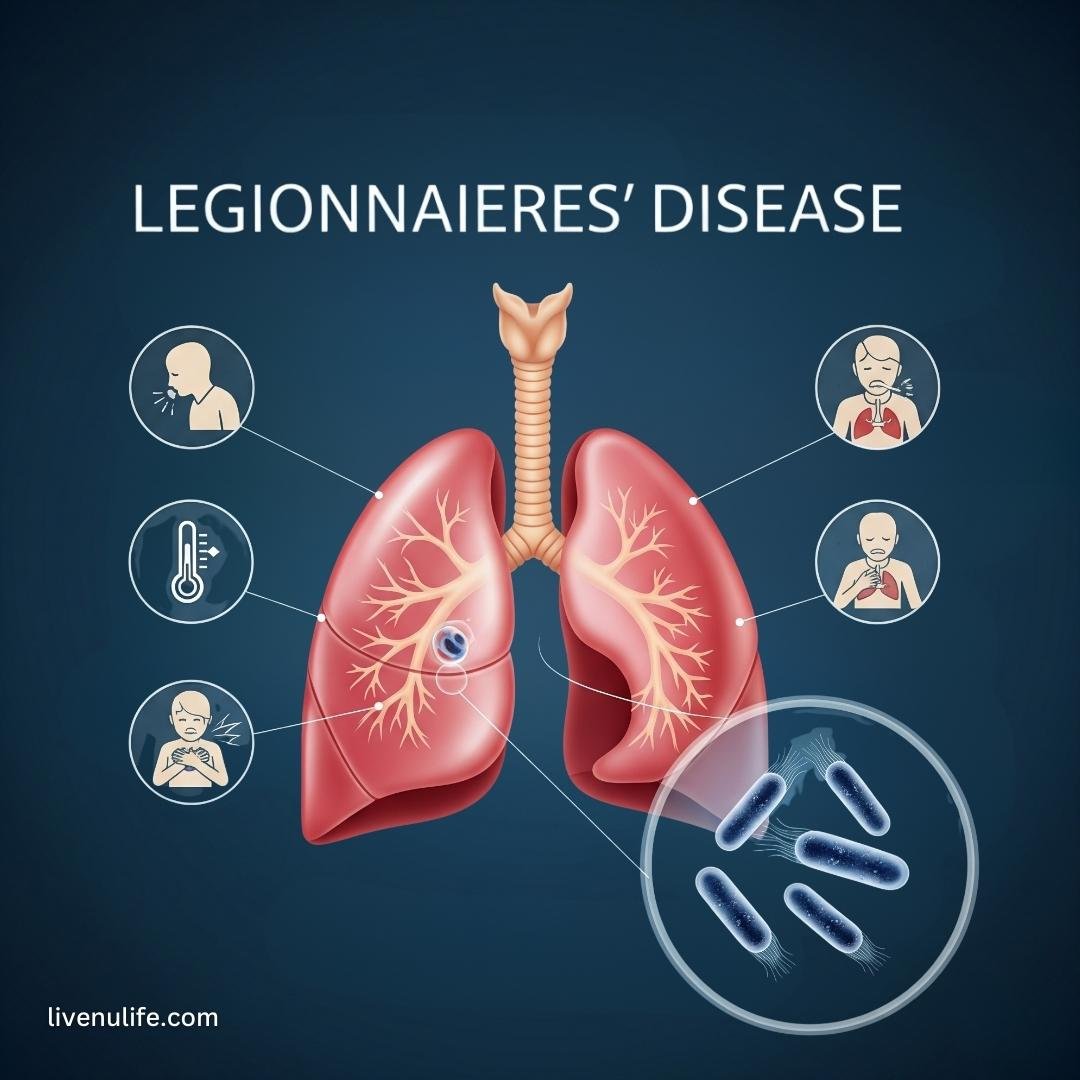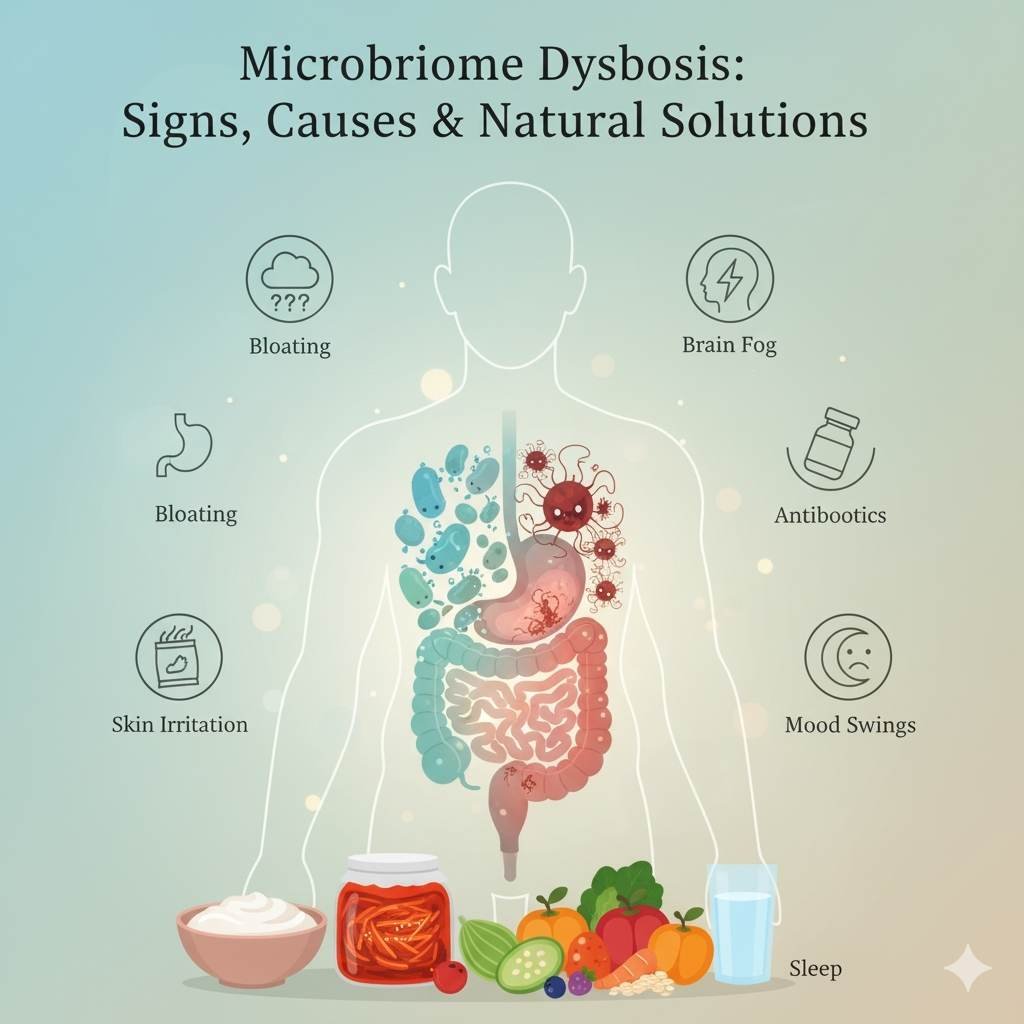Table of Contents
ToggleLegionnaires Disease – Symptoms, Causes, and Prevention
Legionnaires disease can scare people, so let’s make it simple & kind. It is a lung infection caused by a germ called Legionella that lives in water systems like cooling towers, showers, hot tubs & pipes. People get sick when they breathe tiny water drops with this germ, not by touching or from person to person. No vaccine is available for this, but quick care with the right treatment helps many people get well.
What is Legionnaires Disease?
- It is a serious type of pneumonia caused by Legionella bacteria.
- It starts from 2 to 10 days after contact with the germ.
- It differs from Pontiac fever, which is a milder illness that does not involve lung infection.
What it is not
- It is not a cold or the regular flu, because it affects the lungs more deeply and can be severe.
- It’s not spread by sharing food or casual touch in most cases.
- This is not caused by dirty air alone; it comes from water mists with the germ.
Who is at higher risk?
- People of old age, people who smoke more, people who have an illness, or have low immunity.
- People who are exposed to poorly kept water systems in buildings or travel stays.
Quick signs to notice Legionnaires Disease
- Fever, cough, short breath, chest pain.
- Headache, muscle pain, tummy upset, and confusion in some people.
- Simple prevention idea
- Safe building, water care & clean systems reduce risk for everyone.

Symptoms of Legionnaires Disease
Legionnaires disease can feel like a bad flu at first, then it turns into tough pneumonia if not treated fast. You must watch the body’s early signs, then the heavy chest signs, especially in older people, smokers, or those with weak immunity. Seek care fast if these show up. This illness needs antibiotics. It gets worse without care. Stay alert. Stay safe.
Flu-like signs
- Fever that can go high, even 104 F. Feels hot, chills may come too.
- Dry or with mucus. Sometimes, there is blood in spit.
- Headache & muscle aches. The body feels weak and tired.
- Nausea, vomiting, or loose stool can happen.
Severe pneumonia signs
- Shortness of breath. Breathing feels hard. Not getting enough air inside.
- Chest pain, worse when breathing in.
- Feels fuzzy or is not thinking clearly.
- Symptoms usually start after 2-10 days of entering germs in the lungs.
Who is at higher risk?
- People aged over 50 have higher risks.
- Smokers’ Lungs get hit harder, and illness gets worse.
- Weak immunity: Transplant, cancer care, steroids, and long illness.
- Chronic lung disease or diabetes can raise the risk, too.
When to act fast
- If you feel a Fever with cough plus chest pain or breath trouble. Go to a clinic quickly.
- If older, a smoker, or have weak immunity, do not wait. Early treatment saves lives.
Doctors first check your lungs through various tests and start antibiotics early for Legionnaires disease. Quick care lowers the risk of death and helps with full recovery.

Causes of Legionnaires Disease
Legionnaires disease starts with tiny germs in water called Legionella pneumophila. They live in warm water, then spread in mist or steam that people breathe in. No smell. No taste. But it can go deep into the lungs & cause bad pneumonia. It does not spread person to person. It comes from water that went wrong.
Main sources that can spread it:
- Contaminated building water systems, like tanks & long pipelines in big buildings
- Hot tubs with poor cleaning or wrong chlorine & pH levels
- Cooling towers that push out warm mist into the air
Why does it grow so fast in warm water?
- A warm range of 20 to 45°C is perfect for this germ, with the fastest growth near 35 to 37°C
- Heat below 20°C slows it, and heat above 60°C can kill it over time
- Still or low-flow water lets slime layers called biofilm form & protect the germ
- It can hide inside tiny water creatures called amoebae, then multiply more
Risk rises when:
- Water sits still in pipes, tanks, or unused taps & showers
- Scale, rust, or dirt builds up in systems & lowers disinfectant
- Hot tubs or pools run with the wrong chlorine or pH levels
Note: People breathe small water drops from these places, like mist or spray.

Incubation Period of Legionnaires Disease
Legionnaires disease can start soon after contact with the germs that cause it. Most people feel sick in 2–10 days after exposure. Some may take a bit longer. Early care helps. It can save lungs & life.
What happens first
- First signs often show in days 2–6. Fever starts with a Headache, Tired feeling, Mild cough, and Weakness. Appetite goes down. Some feel muscle pain. Some get tummy upset.
- Many people get sick around day 5–6. This is common. Still inside the 2–10 day window.
What happens later
- After a few days, the cough gets worse. Chest hurts. Breathing gets hard. High fever. Some may see blood in mucus. Confusion can happen. This can turn into bad pneumonia fast.
- A small group may show symptoms up to 14–16 days after exposure. Rare, but seen in some outbreaks.
Why quick care matters
- Early checkup & tests help doctors start the right antibiotics fast. This lowers the risk of lung failure & death. Delay can lead to ICU care.
- Go to a clinic or hospital at once if fever, cough, chest pain, or trouble breathing appear in the 2–10 day window after possible exposure to water mist or cooling systems.
Key point
Typical incubation is 2–10 days. Early signs are mild, later signs are serious. Quick medical care protects life.

Treatment for Legionnaires Disease
Treatment for Legionnaires disease needs quick care & the right antibiotics. Doctors give macrolides or fluoroquinolones first because they reach the germ inside the lungs & work well against it.
What doctors use
Antibiotics: Doctors mainly use macrolides like azithromycin or fluoroquinolones like levofloxacin for a cure.
If one option cannot be used, doctors may switch within these groups based on health needs & safety.
Hospital care
Many people need hospital care, especially with breathing trouble, low oxygen, or other illnesses.
Care may include oxygen, fluids, fever control & close checks from the care team.
How long does treatment last
Antibiotics often run from 7 to 14 days according to the current situation, test reports, and matter seriousness.
Some cases may need up to 2 to 3 weeks, especially if severe or slow to improve.
Recovery timeline
Many start feeling better within a week once treatment begins, though cough & tiredness can last longer.
Returning to full strength can take more time after a tough lung infection.
Why speed matters
Fast treatment lowers the risk of bad outcomes & may shorten hospital stay.
Both macrolides & fluoroquinolones show similar survival results overall in studies.
Key points
- Start antibiotics fast for Legionnaires disease.
- Macrolides or fluoroquinolones are first-line.
- Hospital care if symptoms are severe.

How to Prevent Legionnaires Disease
Legionnaires disease spreads through tiny water drops from dirty systems, not by touch or food. Clean water keeps families safe. Start now. Keep it simple. Keep it steady.
Clean water systems
- Make a water plan for buildings to check temperature, flow & disinfectant levels on a schedule.
- Flush rarely used taps weekly to stop still water & slime build up.
- Fix leaks, remove dead-end pipes, and keep pipes moving with recirculation where needed.
Cooling towers care
- Clean & disinfect at least once a year; some sites need every six months based on risk & grime.
- Control scale, rust, dirt, biofilm, use automated disinfectant control, and keep good records on site.
- Keep towers away from air intakes, use drift eliminators, and flush low-flow lines weekly.
Air conditioners note
- Large building HVAC that uses cooling towers needs the same clean, disinfect, monitor cycle to cut spray risk.
- Keep filters & drain pans clean so water does not sit still & grow germs.
Safe hot water
- Store hot water above 60°C, keep the loop above 49 to 50°C to block Legionella growth range.
- Cold water should stay below 20°C when possible to slow growth.
- Be careful: water at 60°C can burn skin fast, use mixing valves at taps to blend safe use temps.
Simple home habits
- Run hot water for a while if a tap or shower was not used.
- Clean shower heads & filters often to remove slime & scale.
- Do not use plain water in car wash tanks or screen wash; use real cleaner fluid only.
Public health steps
- Use ASHRAE 188 style water programs in hospitals, hotels, care homes & big sites.
- Track temperature, disinfectant, flushing, clean dates, test steps, & fixes in a log.
- Work with local health rules & updates from CDC or ECDC for current guidance.
Trust comes from steady care, simple checks, & clean records. Small steps stop Legionnaires disease before it starts.
Complications of Legionnaires’ Disease
Legionnaires’ disease can hit hard. It is a lung infection that can turn serious fast. It may lead to big problems if care is late or weak. Please read this with care. It can save a life.
What can go wrong
- Severe pneumonia can lead to breathing failure. Lungs get filled with infection. Oxygen drops. A person may need oxygen or a breathing machine in the ICU. Delay in care raises the risk. Quick tests & the right antibiotic help.
- Kidney problems can happen. Some people get acute kidney injury. It can come with rhabdomyolysis, low sodium, or shock. A few need dialysis for some time. Most improve with fast care.
- Septic shock can start when blood pressure falls. Organs do not get blood. Brain & kidneys suffer first. This is an emergency. ICU care is needed at once.
- Long-term issues can stay even after a cure. Many people feel deep tiredness for months. Some have weak breath, cough, or slow recovery in daily work. A few report memory or focus issues. Follow-up helps track healing.
Who is at higher risk?
Age over 50, smokers, or weak immunity.
This post reflects medical guidance from CDC, Mayo Clinic, StatPearls, & recent studies on long-term effects. Seek urgent care if fever, cough, or breath trouble start. Early treatment saves lives.
Final Thoughts
Legionnaires disease is a lung infection that comes from tiny water drops with germs, not from person to person, and quick care with the right antibiotic can save life & breathe easier again. Many people recover well, but delays can lead to breathing trouble & other problems, so fast action matters a lot.
Key points
- It starts like the flu with fever, cough, muscle pain & can get worse in 2 to 3 days with short breath, chest pain, tummy upset, or confusion.
- Older adults, smokers & people with weak body defense have a higher risk & need a quick check if they feel sick after being near hot water, spa, or big water systems.
- Doctors use chest X-ray, urine test & sputum test to find the germ & start antibiotics early.
- Most cases need antibiotics for 1 to 3 weeks & sometimes oxygen or hospital care if breathing is hard.
- Pontiac fever is the mild form & gets better on its own, but Legionnaires’ disease needs quick treatment.
Simple care steps
- Seek care fast if fever with cough & short breath starts after hotel stay, cruise, spa, or shower in a place with big water systems.
- Take all medicines as told & go for follow-up until fully well.
Safer buildings
- Keep hot water above 60°C, cold below 20°C, clean shower heads, flush rarely used taps & control water germs in buildings.
Final thought: quick check, early antibiotics & clean water systems make a real difference with Legionnaires’ disease.
Related Articles You May Find Helpful
Learn more about Health and Fitness and its role in overall wellness.
Discover proven strategies on How to Prevent Autoimmune Disease naturally.
Struggling with joint pain? Read our guide on Shoulder Tendonitis.
Get complete insights on What is Tennis Elbow and its causes.
Understand the basics of Fitness and Nutrition for a balanced lifestyle.
Don’t miss our expert Health and Fitness Tips to stay active every day.
Find effective methods for Tennis Elbow Treatment and regain strength.
Improve your heart naturally with these Foods to Improve Heart Health.
Explore why Autoimmune Diseases are increasing worldwide.
Learn essential steps for Autoimmune Disease Prevention.
Read a complete guide on Typhoid causes and prevention.
Identify early warning signs with our post on Typhoid Symptoms.
Understand causes, diet, and care in our full guide on Fatty Liver.
Recognize early Fatty Liver Symptoms before they worsen.
FAQs
Q: What is Legionnaires disease ?
It is a lung infection caused by Legionella germs. It is a type of pneumonia & needs quick doctor care.
Q: How do people get Legionnaires disease ?
By breathing mist from water systems with the germs. Not by kissing, hugging, or sharing a room.
Q: Who is at high risk of Legionnaires disease ?
People over 50, smokers, or those with weak body defense, lung disease, cancer, diabetes, or kidney or liver problems.
Q: What are the signs of Legionnaires disease ?
Fever, cough, short breath, chest pain, headache, body aches, tummy issues, and confusion. Starts 2 to 10 days after contact.
Q: Is Legionnaires disease contagious?
No, it does not spread person to person in general. A rare spread is reported, but not in the usual way.
Q: How is Legionnaires disease tested?
Chest X-ray, urine antigen test, blood work, & sputum test to find the germ.
Q: How Legionnaires disease is treated?
Antibiotics by a doctor. Some need hospital care if severe. Early treatment helps recovery.
Q: How to lower risk of Legionnaires disease ?
Keep building water clean, control warm water, avoid dirty hot tubs, fix stagnant water.







